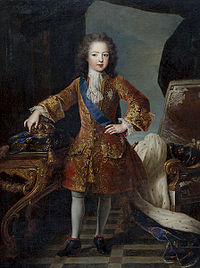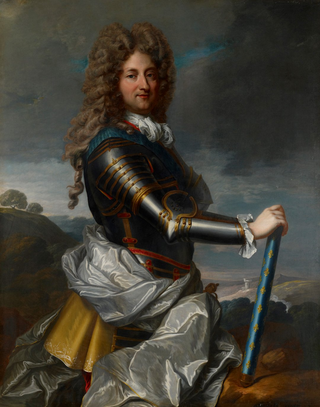
Philippe II, Duke of Orléans, was a French prince, soldier, and statesman who served as Regent of the Kingdom of France from 1715 to 1723. He is referred to in French as le Régent. He was the son of Monsieur Philippe I, Duke of Orleans, and Madame Elisabeth Charlotte, Duchess of Orléans. Born at his father's palace at Saint-Cloud, he was known from birth by the title of Duke of Chartres.

Louis, Duke of Orléans was a member of the House of Bourbon, and as such was a prince du sang. At his father's death, he became the First Prince of the Blood and Duke of Orléans. Known as Louis le Pieux and also as Louis le Génovéfain, Louis was a pious, charitable and cultured prince, who took very little part in the politics of the time.

The Régence was the period in French history between 1715 and 1723 when King Louis XV was considered a minor and the country was instead governed by Philippe II, Duke of Orléans as prince regent.
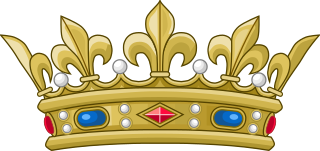
Fils de France was the style and rank held by the sons of the kings and dauphins of France. A daughter was known as a fille de France.

The 4th House of Orléans, sometimes called the House of Bourbon-Orléans to distinguish it, is the fourth holder of a surname previously used by several branches of the Royal House of France, all descended in the legitimate male line from the dynasty's founder, Hugh Capet. The house was founded by Philippe I, Duke of Orléans, younger son of Louis XIII and younger brother of Louis XIV, the "Sun King".

Charles of France, Duke of Berry, was a grandson of Louis XIV of France. Although he was only a grandson of Louis XIV, Berry held the rank of fils de France, rather than petit-fils de France, as the son of the Dauphin, heir apparent to the throne. The Duke of Berry was for seven years (1700–1707) heir presumptive to the throne of Spain, until his elder brother Philip V of Spain fathered a son in 1707.
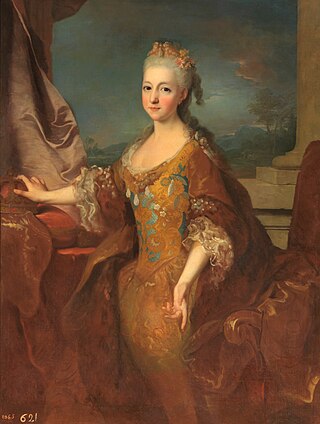
Louise Élisabeth d'Orléans was Queen of Spain as the wife of King Louis I. Their reign is regarded as one of the shortest in history, lasting for seven months. Louise Élisabeth was the fourth daughter to survive to adulthood born to Philippe II, Duke of Orléans and Françoise Marie de Bourbon.

Charlotte Aglaé d'Orléans was Duchess of Modena and Reggio by marriage to Francesco III d'Este. She was the third daughter of Philippe II, Duke of Orléans and his wife, Françoise-Marie de Bourbon. She was born a princesse du sang, and had ten children, including Ercole III d'Este, Duke of Modena.

Élisabeth Charlotte d'Orléans was a petite-fille de France and duchess of Lorraine and Bar by her marriage to Duke Leopold. She was regent of the duchy during the minority (1729–1730) and absence (1730–1737) of her son and suo jure princess of Commercy from 1737–1744. Among her children was Francis I, Holy Roman Emperor, the co-founder of the House of Habsburg-Lorraine.

Auguste Marie Johanna of Baden-Baden, later Auguste Marie Jeanne, Duchess of Orléans, was a member of the ruling family of Baden-Baden who became Duchess of Orléans as the wife of Louis d'Orléans, Duke of Orléans. Her husband was a grandson of her father's former enemy, Louis XIV of France. Known in France as Auguste de Bade, she died in childbirth. She is an ancestor of Louis Philippe I and of several members of royal families of Europe, such as the Spanish and Italian royal families, as well as the present Grand Duke of Luxemburg.

Anna Gonzaga was an Italian French noblewoman and salonist. The youngest daughter of Charles Gonzaga, Duke of Mantua and Montferrat, and Catherine de Mayenne, Anna was "Princess Palatine" as the wife of Edward of the Palatinate, a grandson of King James I of England and uncle to King George I of Great Britain. She bore Edward three children, all daughters. Had Anna not converted Edward to Catholicism, the English throne might have passed to their descendants.

Marie Anne de Bourbon, Légitimée de France, born Marie Anne de La Blaume Le Blanc, by her marriage Princess of Conti then Princess Dowager of Conti, suo jureDuchess of La Vallière and of Vaujours was a French noblewoman as the eldest legitimised daughter of Louis XIV, King of France, born from his mistress Louise de La Vallière, and the king's favourite daughter. She married Louis Armand I, Prince of Conti, in 1680 and was widowed in 1685. She never married again and had no issue. Upon her mother's death, she became the suo jure Duchess of La Vallière and of Vaujours.

Françoise Marie de Bourbon was the youngest illegitimate daughter of King Louis XIV of France and his maîtresse-en-titre, Françoise-Athénaïs de Rochechouart, Marquise de Montespan. At the age of 14, she married her first cousin Philippe d'Orléans, the future regent of France during the minority of Louis XV. Through two of her eight children, she became the ancestress of several of Europe's Roman Catholic monarchs of the 19th and 20th centuries—notably those of Belgium, Italy, Portugal, Spain, and France.

The House of Bourbon-Penthièvre was an illegitimate branch of the House of Bourbon, thus descending from the Capetian dynasty. It was founded by the duc de Penthièvre (1725–1793), the only child and heir of the comte de Toulouse, the youngest illegitimate son of Louis XIV of France and the marquise de Montespan, and his wife, Marie Victoire de Noailles, the daughter of Anne Jules de Noailles, duc de Noailles.

A prince du sang or prince of the blood is a person legitimately descended in male line from a sovereign. The female equivalent is princess of the blood, being applied to the daughter of a prince of the blood. The most prominent examples include members of the French royal line, but the term prince of the blood has been used in other families more generally, for example among the British royal family and when referring to the Shinnōke in Japan.

Louise Françoise, Duchess of Bourbon was the eldest surviving legitimised daughter of Louis XIV of France and his maîtresse-en-titre Françoise-Athénaïs, Marquise de Montespan. She was said to have been named after her godmother, Louise de La Vallière, the woman her mother had replaced as the king's mistress. Before her marriage, she was known at court as Mademoiselle de Nantes.

Louise Élisabeth de Bourbon was a daughter of Louis III de Bourbon, Prince of Condé, and his wife, Louise Françoise de Bourbon, légitimée de France, a legitimised daughter of King Louis XIV of France and his famous mistress, Madame de Montespan.

Marie Thérèse de Bourbon was the titular Queen consort of Poland in 1697. She was the daughter of the Prince of Condé. As a member of France's reigning House of Bourbon, she was a princesse du sang.
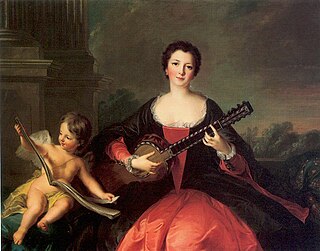
Philippine Élisabeth Charlotte d'Orléans was the daughter of Philippe II, Duke of Orléans, and his wife, Françoise-Marie de Bourbon, the youngest legitimised daughter of King Louis XIV and Madame de Montespan. As a member of the reigning House of Bourbon and the House of Orléans, Philippine Élisabeth was a Princesse du Sang. She died of smallpox at the age of 19.

Anne Charlotte of Lorraine was the Abbess of Remiremont and Mons. She was the thirteenth of fourteen children of Leopold, Duke of Lorraine, and his spouse Élisabeth Charlotte d'Orléans. Her mother was the niece of Louis XIV of France and sister of Philippe II, Duke of Orléans and Regent of France during the minority of Louis XV.



